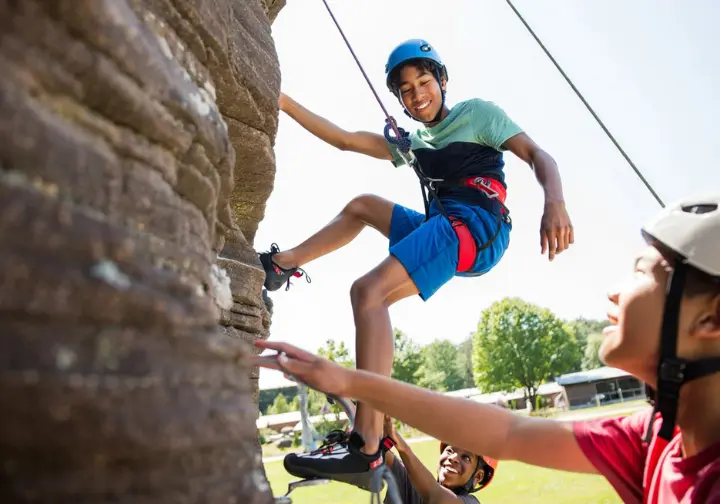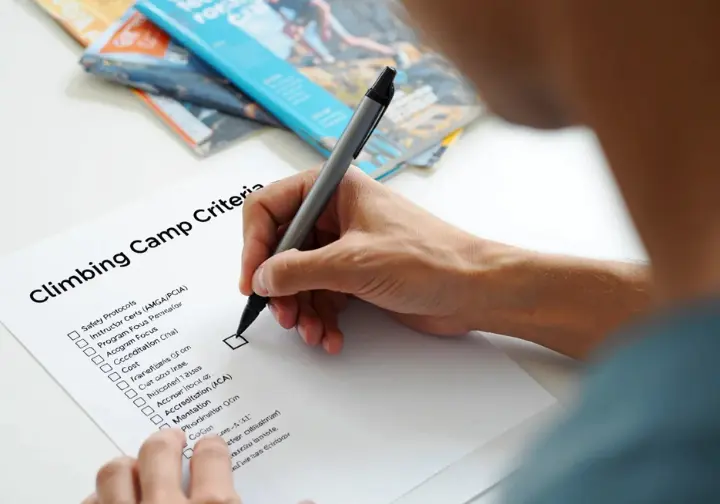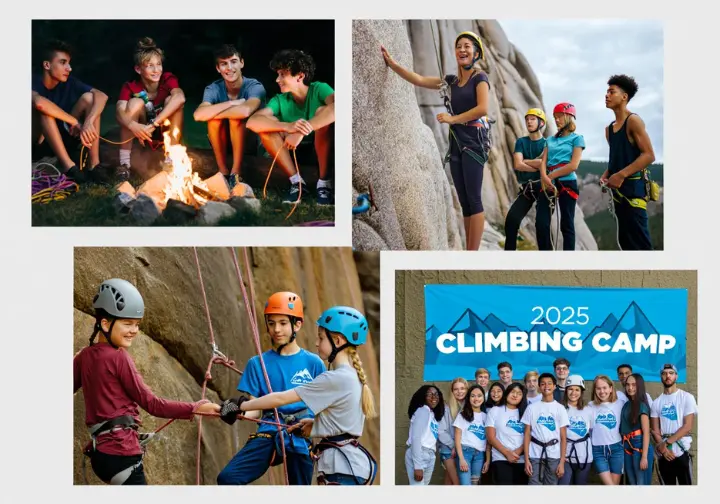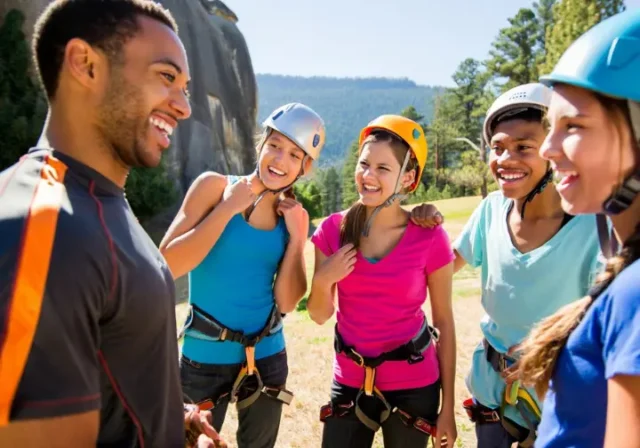In this article
Choosing the right rock climbing sleepaway camp can feel like a steep climb, but it’s a vital step for fostering your teen’s passion and personal climbing skills. This definitive guide will equip you with the knowledge to navigate the options and find the perfect camp experience for any young climber. We’ll explore the unique benefits of immersive climbing camps, how to evaluate safety and instruction, discover top-rated programs, and help you make an informed decision. Ready to send your teen on an unforgettable adventure?
Why Choose a Rock Climbing Sleepaway Camp?

Specialized camps offer significant advantages beyond typical summer camp activities, focusing on skill acceleration and personal growth in an immersive outdoor setting. Understanding the value of a dedicated rock climbing sleepaway camp experience is key for parents looking to support their child’s development in the sport of rock climbing. These programs provide a unique environment for teens, as campers, to flourish and experience amazing rock climbing.
Accelerated Skill Development Environment
Sleepaway camps provide concentrated blocks of time dedicated solely to climbing, allowing for rapid skill acquisition compared to weekly lessons or occasional rock-climbing trips. This immersive format means teens live and breathe climbing, constantly reinforcing techniques. The focused environment minimizes distractions, enabling deep dives into skills like belaying or rappelling. Many programs offer structured learning and skill progression tailored to different abilities, from beginner to advanced climber. Even competition climbers can find programs to hone their edge.
Instruction is typically delivered by experienced climbing instructors, ensuring teens are learning correct techniques from the start and understanding rock-craft. Access to diverse climbing terrain, from a classic boulder field to top-rope cliffs, exposes teens to various styles and challenges, including specific skills like bouldering on different boulders. This variety accelerates learning and helps teens discover their preferred climbing disciplines. Considering age-appropriate training priorities and focusing on climbing-specific strength is also part of quality programs.
Daily climbers practice under expert supervision allows for immediate feedback, preventing bad habits. Consistent application of learned skills on real outdoor rock solidifies understanding of how to tackle different climbs. Many camps structure their curriculum progressively, building from foundational techniques to advanced maneuvers and even advanced climbs, always emphasizing fundamental safety protocols. Learning to assess a rock type or a boulder problem becomes second nature.
The group setting fosters peer learning, as teens observe and encourage each other. This collaborative atmosphere can push individuals to try harder climbing routes or more difficult climbs. Beyond technical skills, camps often incorporate workshops on knot tying, anchor assessment, and route reading, creating well-rounded climbers. Some may even touch on what it takes to tackle 100-foot climbs on a sheer cliff or rock wall.
Building Confidence and Independence
Successfully navigating challenging climbs builds immense self-confidence and resilience for every camper. Overcoming physical obstacles on various rocks translates directly into a stronger belief in their capabilities. The camp environment provides repeated opportunities for these confidence-boosting achievements, contributing to building lasting character and resiliency. Adequate sleep and rest are also factored into the daily camp agenda to ensure campers are ready for each day’s adventure.
The sleepaway nature requires teens to manage daily routines, personal belongings (like sleeping bags and sleeping pads), and social interactions away from home. This fosters independence, self-reliance, and responsibility in a structured, supportive setting, often within a wilderness camp atmosphere. Learning to navigate camp life successfully builds life skills, contributing to personal growth that requires understanding fundamental rules.
Problem-solving is inherent in climbing; teens figure out sequences and manage fear. Camps actively encourage this, teaching critical thinking. Living and climbing in a group necessitates teamwork and effective communication. This shared experience builds strong bonds. The benefits of outdoor experiences for youth are widely recognized and form a core part of these programs, including activities like hiking or gathering around a campfire.
Spending time outdoors fosters an appreciation for nature and can reduce stress. The physical activity combined with the camp environment promotes mental well-being. This connection to the outdoor living experience is a significant benefit, often enhanced by evening campfires and shared stories.
Experiencing Diverse Climbing Destinations
Many camps are located near renowned climbing areas, offering teens access to established climbing destinations and diverse rock formations. This provides experience on different rock type like granite, sandstone, or even basalt rock, which require varied techniques. Exposure to different destinations and terrain broadens a climber’s adaptability. Some awesome climbing sites might even be near a park.
Some camps incorporate travel, taking teens to multiple crags or regions, perhaps even a boulder-strewn ridge. This adventure element enhances the experience, providing exposure to varied landscapes beyond a single base campsite. It aligns with the exploration aspect of climbing. For instance, some camps allow for visiting places like the New River Gorge or areas near Acadia. An avid camp participant might experience several unique geological settings.
Climbing in established destinations allows teens to experience iconic climbing routes and understand area-specific ethics. It connects them to the broader climbing community. These camps often integrate wilderness living skills, teaching responsible camping and promoting minimum impact practices for outdoor climbers. This holistic outdoor education enhances their connection to the environment, instilling a sense of responsible behavior at climbing areas.
The immersive nature of a rock climbing sleepaway camp allows for deeper exploration of a climbing area than a day trip. Teens experience different crags and conditions, absorbing the atmosphere of the location. This depth contributes significantly to their development as climbers. They might even tackle a famous stone mountain or similar landmark if the camp allows.
Evaluating Teen Climbing Camps: Key Criteria

Choosing the right camp involves careful evaluation. This section breaks down the factors to consider, focusing on safety protocols, climbing instructor expertise, program structure, and overall camp philosophy to ensure a positive and productive experience for your teen climber, especially for safety-conscious climbers.
Safety Standards and Accreditation
Safety is paramount when selecting an adventure camp. Look for camps that openly discuss their risk management plans. This includes procedures for gear inspection, site assessment, and emergency response. Adherence to established youth activity risk management protocols is a good indicator of a camp’s commitment. Thorough pre-camp staff training is essential.
Verify the camp’s approach to supervision, particularly staff-to-camper ratios during climbing activities. Accreditation by organizations like the American Camp Association (ACA) indicates a commitment to meeting rigorous standards for health, safety, and operations for the entire camp facility. Ask camps about their accreditation status.
Camps should have clear procedures for medical situations, including access to first aid. Inquire about the medical training of staff and proximity to emergency services. Some regions also have specific state requirements for children’s camps that camps must meet. Investigate the camp’s safety history and reputation.
Instructor Qualifications and Experience
The quality of instruction hinges on staff qualifications. Inquire about the specific certifications held by climbing instructors, looking for credentials from bodies like AMGA or PCIA. The AMGA Single Pitch Instructor certification is a respected standard for teaching rock-climbing in single-pitch terrain. Camp lead instructors should be highly qualified.
Understanding the details of the SPI program standards provides insight into an instructor’s skill level. Beyond technical certifications, look for wilderness medical training like WFA or WFR. Experience working with teenagers is also important. Knowing the distinctions between guide certifications can help you assess the expertise available. Consider if the camp staff meet your expectations.
A low instructor-to-camper ratio during technical climbing instruction is vital for safety and personalized feedback. Clarify these specific ratios with the camp. What kind of instructor background makes you feel most comfortable for your teen, especially if they are an interested camper looking to advance?
Program Focus and Curriculum Details
Camps vary in program focus; some emphasize intensive skill development, while others offer a broader outdoor adventure where climbing is just one component. Understand the camp’s philosophy. Review the specific climbing disciplines taught (e.g., bouldering), top-rope climbing, sport climbing, or even climbing disciplines taught (e.g., trad climbing). The general camp structure should be clear.
Examine the typical daily schedule and curriculum. Look for a balance between instruction, free climbing time, rest, and other camp activities. Many camps provide typical daily schedules and sample itineraries on their websites. Inquire about the types of climbing terrain utilized, including any on-site climbing wall. Some camps offer a curriculum covering various climbing disciplines or have specialized program structures to suit campers of different levels, including advanced campers.
Consider the non-climbing activities offered, such as hiking, swimming, campfires (perhaps campfire/yard games), team-building games, or wilderness skills workshops. Evaluate whether these complement the climbing focus and align with your teen’s broader interests for an awesome summer camp experience, especially during overnight camp sessions like a 5-night sleepaway. For the passionate climber, the focus will be on time on the rock.
Logistics: Cost, Duration, Location, and Gear
Camp logistics and costs vary widely based on duration, location, and included gear. Establish a budget and compare tuition fees, noting what’s included versus extra costs. Many camps provide details on typical tuition ranges and session lengths and are transparent about potential add-on costs. This includes costs for camping overnight.
Session durations typically range from one to multiple weeks. Consider your teen’s age and experience. Location influences travel and the type and quality of climbing available. Determine the camp’s policy on climbing gear; many provide essential technical gear like ropes and helmets, but campers might need personal items. Some camps provide essential technical gear (ropes, harnesses, helmets). Always obtain sample packing lists and gear requirements well in advance, including needs for sleeping bags and sleeping pads.
Understand accommodation (e.g., tents at a campsite, cabins, dorms) and meal provisions as part of the camp setup. Inquire about how dietary restrictions or allergies are handled. The outdoor living situation significantly impacts the overall camp experience, including ensuring adequate sleep and resting/recovery periods.
Top Teen Rock Climbing Sleepaway Camps for 2025

Based on our research focusing on program quality, safety standards, instructor expertise, and unique offerings, here are some of the top teen rock climbing sleepaway camps across different regions and specialties to consider for your aspiring climber. These camps aim to provide an unforgettable outdoor adventure.
Best for Technical Skill Progression (Northeast)
These camps excel in structured curriculums designed to significantly advance a teen’s climbing technique and knowledge, ideal for dedicated climbers.
- Acadia Mountain Guides (AMGCS – ME/NH) | Structured RockPro series for focused skill development (sport/trad).
- Petra Cliffs (VT) | Offers specialized programs including leadership components alongside technical instruction for sport climbers and others.
- Adirondack Camp (NY) | Integrates climbing instruction within a traditional camp setting in a classic climbing region.
- North Country Climbing Center Camps (NH) | Focuses on climbing development with experienced guides in the White Mountains region, catering to inclined campers.
Best All-Around Adventure & Fun Focus
Balancing solid climbing instruction with a traditional summer camp atmosphere and diverse activities.
- Stone Mountain Adventures (SMA – PA) | Own climbing crag, multi-activity focus, optional ‘Masters’ climbing program; Stone Mountain Adventures is a well-known summer camp sma.
- Wilderness Adventure (VA) | Blends climbing instruction with backpacking and other outdoor skills in the Blue Ridge Mountain range.
- Deer Crossing Camp (CA) | Long-standing camp with climbing as a key part of a broader wilderness program.
- Cheley Colorado Camps (CO) | Established camp offering climbing within a comprehensive Western outdoor experience.
Top Regional Camps (Beyond Northeast)
Highlighting excellent programs located in other major US climbing regions, some catering to specific groups like Minnesota-based climbers if programs extend there.
- Colorado Mountain Club (CMC – CO) | State-licensed, experienced educators offering rock-climbing trips in prime Colorado locations (e.g., Penitente).
- ACE Adventure Resort / Adventures on the Gorge (WV) | Access to world-class climbing in the New River Gorge area.
- Camp Ondessonk (IL) | ACA accredited camp offering climbing instruction in the Shawnee National Forest park.
- Adventure Treks (PNW) | Multi-week adventure travel programs including climbing in the Pacific Northwest.
Specialized Camp Experiences
Camps catering to specific demographics or offering unique program structures for a memorable sleepaway experience.
- Alpengirl Camp (Various Locations) | Well-regarded girls-only adventure camp including rock climbing components.
- Shaffer’s High Sierra Camp (CA) | Offers traditional camp experiences including climbing in a High Sierra setting.
- Remarkably Human Adventures (NY – Adirondacks) | Smaller group adventures focusing on climbing and camping skills.
- The Mountaineers Youth Programs (WA) | Offers various camps and courses including climbing instruction near Seattle.
Key Takeaways on Choosing a Teen Climbing Camp
Prioritize safety; verify climbing instructor qualifications (AMGA/PCIA), supervision ratios, and emergency protocols. ACA accreditation is a positive indicator. Match the camp’s program focus (technical skills vs. broad adventure) and curriculum (climbing disciplines taught) to your teen’s individual skill level, interests, and goals. Understand the full cost, including tuition and extras. Look beyond brochures; ask detailed questions of camp directors. The right rock climbing sleepaway camp offers more than just time on the stone; it fosters confidence, independence, and a lifelong appreciation for the outdoors.
Frequently Asked Questions about Teen Rock Climbing Sleepaway Camps
What qualifications should instructors ideally have? >
How much does a typical rock climbing sleepaway camp cost? >
Does my teen need prior climbing experience? >
What are the most important safety factors to ask about? >
We are a participant in the Amazon Services LLC Associates Program, an affiliate advertising program designed to provide a means for sites to earn advertising fees by advertising and linking to Amazon.com. As an Amazon Associate I earn from qualifying purchases. We also participate in other affiliate programs. The information provided on this website is provided for entertainment purposes only. We make no representations or warranties of any kind, expressed or implied, about the completeness, accuracy, adequacy, legality, usefulness, reliability, suitability, or availability of the information, or about anything else. Any reliance you place on the information is therefore strictly at your own risk. Additional terms are found in the terms of service.








